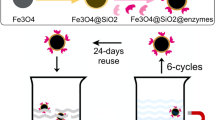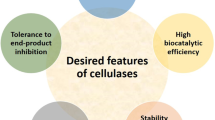Abstract
β-Glucosidase hydrolyzes cellobiose to glucose and is an important enzyme in the consortium used for hydrolysis of cellulosic and lignocellulosic feedstocks. In the present work, β-glucosidase was covalently immobilized on non-porous magnetic particles to enable re-use of the enzyme. It was found that particles activated with cyanuric chloride and polyglutaraldehyde gave the highest bead-related immobilized enzyme activity when tested with p-nitrophenyl-β-D-glucopyranoside (104.7 and 82.2 U/g particles, respectively). Furthermore, the purified β-glucosidase preparation from Megazyme gave higher bead-related enzyme activities compared to Novozym 188 (79.0 and 9.8 U/g particles, respectively). A significant improvement in thermal stability was observed for immobilized enzyme compared to free enzyme; after 5 h (at 65 °C), 36 % of activity remained for the former, while there was no activity in the latter. The performance and recyclability of immobilized β-glucosidase on more complex substrate (pretreated spruce) was also studied. It was shown that adding immobilized β-glucosidase (16 U/g dry matter) to free cellulases (8 FPU/g dry matter) increased the hydrolysis yield of pretreated spruce from ca. 44 % to ca. 65 %. In addition, it was possible to re-use the immobilized β-glucosidase in the spruce and retain activity for at least four cycles. The immobilized enzyme thus shows promise for lignocellulose hydrolysis.






Similar content being viewed by others
References
Weng, J. K., Li, X., Bonawitz, N. D., & Chapple, C. (2008). Current Opinion in Biotechnology, 19, 166–172.
Bommarius, A. S., Katona, A., Cheben, S. E., Patel, A. S., Ragauskas, A. J., Knudson, K., et al. (2008). Metabolic Engineering, 10, 370–381.
Chauve, M., Mathis, H., Huc, D., Casanave, D., Monot, F., & Lopes Ferreira, N. (2010). Biotechnology for Biofuels, 3, 1–8.
Merino, S. T., & Cherry, J. (2007). Advances in Biochemical Engineering/Biotechnology, 108, 95–120.
Sternberg, D. (1976). Applied and Environmental Microbiology, 31, 648–654.
Mateo, C., Palomo, J. M., Fernandez-Lorente, G., Guisan, J. M., & Fernandez-Lafuente, R. (2007). Enzyme and Microbial Technology, 40, 1451–1463.
Sheldon, R. A. (2007). Advanced Synthesis and Catalysis, 349, 1289–1307.
Koneracká, M., Kopcanský, P., Timko, M., Ramchand, C. N., Saiyed, Z. M., Trevan, M., et al. (2006). In J. M. Guisan (Ed.), Methods in biotechnology. Immobilization of enzymes and cells (pp. 217–228). Totowa: Humana.
Schultz, N., Syldatk, C., Franzreb, M., & Hobley, T. J. (2007). Journal of Biotechnology, 132, 202–208.
Franzreb, M., Ebner, N., Siemann-Herzberg, M., Hobley, T. J., & Thomas, O. R. T. (2007). In M. Etzel, A. Shukla, & S. Gadam (Eds.), Process scale bioseparations for the biopharmaceutical industry. Product recovery by high-gradient magnetic fishing (pp. 83–121). Cambridge: CRC.
Franzreb, M., Siemann-Herzberg, M., Hobley, T. J., & Thomas, O. R. T. (2006). Applied Microbiology and Biotechnology, 70, 505–516.
Bissett, F., & Sternberg, D. (1978). Applied and Environmental Microbiology, 35, 750–755.
Calsavara, L. P., De Moraes, F. F., & Zanin, G. M. (2001). Applied Biochemistry and Biotechnology, 91–93, 615–626.
Shinkai, M., Honda, H., & Kobayashi, T. (1991). Biocatalysis, 5, 61–69.
Singh, R., Zhang, Y.-W., Nguyen, N.-P.-T., Jeya, M., & Lee, J.-K. (2011). Applied Microbiology and Biotechnology, 89, 337–344.
Tu, M., Zhang, X., Kurabi, A., Gilkes, N., Mabee, W., & Saddler, J. (2006). Biotechnology Letters, 28, 151–156.
Zhang, Y., Xu, J. L., Li, D., & Yuan, Z. H. (2010). Biocatalysis and Biotransformation, 28, 313–319.
Dekker, R. F. H. (1990). Applied Biochemistry and Biotechnology, 23, 25–39.
McCleary, B. V., & Harrington, J. (1988). Methods in Enzymology, 160, 575–583.
Berghem, L. E. R., & Pettersson, L. G. (1974). European Journal of Biochemistry, 46, 295–305.
Bradford, M. M. (1976). Analytical Biochemistry, 72, 248–254.
Ghose, T. K. (1987). Pure and Applied Chemistry, 59, 257–268.
Sluiter, A., Hames, B., Ruiz, R., Scarlata, C., Sluiter, J., & Templeton Crocker, D. (2008). Laboratory Analytical Procedure (LAP). Determination of structural carbohydrates and lignin in biomass. Golden: National Renewable Energy Laboratory.
Mozhaev, V. V., Melik-nubarov, N. S., Sergeeva, M. V., Sikrnis, V., & Martinek, K. (1990). Biocatalysis and Biotransformation, 3, 179–187.
Pedroche, J., Yust, M., Mateo, C., Fernández-Lafuente, R., Girón-Calle, J., Alaiz, M., et al. (2007). Enzyme and Microbial Technology, 40, 1160–1166.
Tengborg, C., Galbe, M., & Zacchi, G. (2001). Enzyme and Microbial Technology, 28, 835–844.
Lupoi, J. S., & Smith, E. A. (2011). Biotechnology and Bioengineering, 108, 2835–2843.
Wong, L. S., Khan, F., & Micklefield, J. (2009). Chemical Reviews, 109, 4025–4053.
Dekker, R. F. H. (1986). Biotechnology and Bioengineering, 28, 1438–1442.
Sørensen, A., Lübeck, P. S., Lübeck, M., Teller, P. J., & Ahring, B. K. (2011). Canadian Journal of Microbiology, 57, 638–650.
Balcão, V. M., Mateo, C., Fernández-Lafuente, R., Malcata, F. X., & Guisán, J. M. (2001). Biotechnology Progress, 17, 537–542.
Mohy Eldin, M. S., El Enshasy, H. A., Hassan, M. E., Haroun, B., & Hassan, E. A. (2012). Journal of Applied Polymer Science, 125, 3820–3828.
Rossi, L. M., Quach, A. D., & Rosenzweig, Z. (2004). Analytical and Bioanalytical Chemistry, 380, 606–613.
Acknowledgments
Financial support from the Nordic Energy Research (NER) fund grant TFI PK-BIO04 is gratefully acknowledged. We would like to thank Novozymes for providing the enzyme preparations (Novozym 188 and Celluclast 1.5L) and Paper and Fibre Institute Norway for providing pretreated spruce.
Author information
Authors and Affiliations
Corresponding author
Rights and permissions
About this article
Cite this article
Alftrén, J., Hobley, T.J. Covalent Immobilization of β-Glucosidase on Magnetic Particles for Lignocellulose Hydrolysis. Appl Biochem Biotechnol 169, 2076–2087 (2013). https://doi.org/10.1007/s12010-013-0122-5
Received:
Accepted:
Published:
Issue Date:
DOI: https://doi.org/10.1007/s12010-013-0122-5




